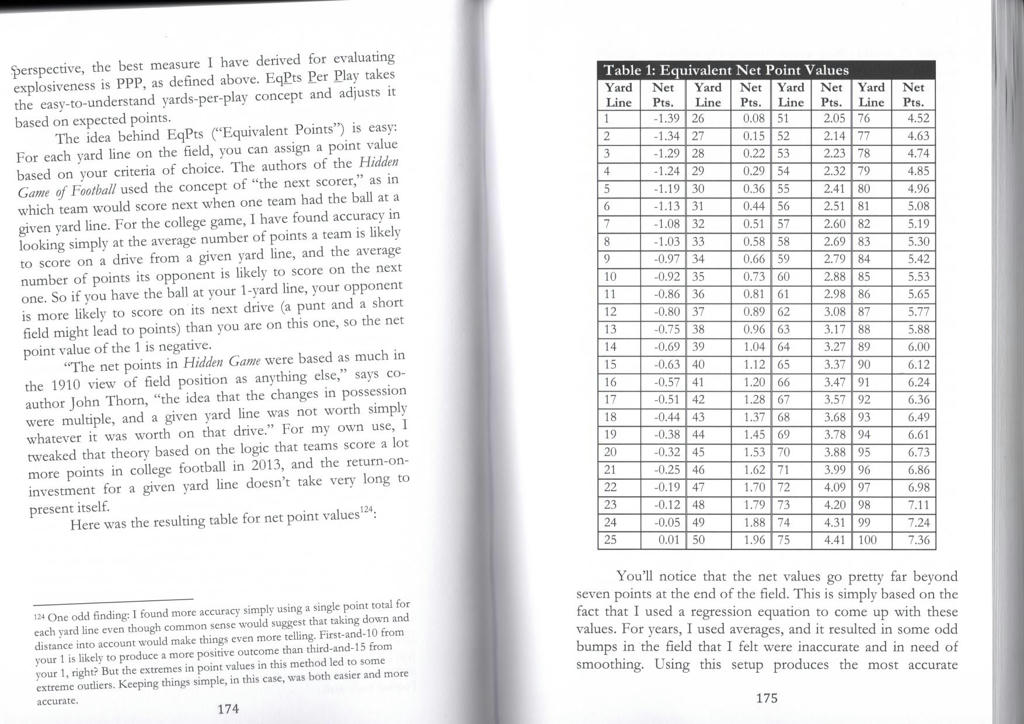- Messages
- 9,920
- Location
- Williamsburg Virginia
Study Hall - College Football, Its Stats and Its Stories
By Bill Connelly, 2013
Here are my notes on an entertaining book written by Bill Connelly who is one of the principals at http://www.footballstudyhall.com/ Great site & highly recommended. Book on Amazon at http://www.amazon.com/Study-Hall-College-Football-Stories/dp/1484989961/ref=sr_1_1?ie=UTF8&qid=1416614366&sr=8-1&keywords=Study Hall Football and they talk about the usual stuff with synopsis. Here’s what I liked:
By Bill Connelly, 2013
Here are my notes on an entertaining book written by Bill Connelly who is one of the principals at http://www.footballstudyhall.com/ Great site & highly recommended. Book on Amazon at http://www.amazon.com/Study-Hall-College-Football-Stories/dp/1484989961/ref=sr_1_1?ie=UTF8&qid=1416614366&sr=8-1&keywords=Study Hall Football and they talk about the usual stuff with synopsis. Here’s what I liked:
- Pages 161-188. Chapter on Advanced Stats 101.
- There are many reasons to buy this book including it just being a good read with a lot of passion. But this chapter is the best for me since it starts to explain how the Study Hall metrics are developed. I’m not going into all the details, partly because there are so many but also because this book was where he was in 2013. I’ve read the book and started following Study Hall and my enjoyment of the game has gone up.
- Anyway here’s the central concept: page 174 For each yard line on the field you assign a point value. Then each play is ranked based on the difference between the starting and finishing position. (The last page has this chart.) Also, “garbage” drives where one team is just running out the clock since they have won are thrown out of the stats. Go to http://www.footballstudyhall.com/ and muck around on the site. Here’s a good breakdown of our 2014 Clemson game. http://www.footballstudyhall.com/20...clemson-football-score-stats-recap/in/6603654
- Page 103. Aaron Schatz three major hindrances to acceptance of college football stats.
- The “best is the enemy of better” concept. {This is true everywhere in life where people just need to chill and enjoy.} Here the idea is that football is so complex in possible starting formations and plays to a “simple” game like baseball that for football “its always going to be imperfect because we don’t know what the play-calls were, what the assignments were.”
- The stats-versus- scouting dichotomy. For football you have to interpret a player’s value both in terms of his stats and the relevant scheme. How many times have we talked about CPJ’s O scheme allowing us to get players (like OL) whose skill set is much more suited to our blocking style than the pro set? Great athletes usually make better players, but not always. A track star like Snoddy isn’t great until football skills are added over top of raw speed.
- The “Broken Tile” problem. “Think of your favorite mosaic. What if there is a busted tile? That’s where your eyes will go.” If I only had a dollar for every time someone pointed out the exceptions in CFB player performance to their high school Scout/Rivals ranking. You always see the problems but don’t appreciate the context is generally correct. The same thing goes for predicting game outcomes. He gets into the small sample size – 12 regular season games per team and over 120 teams. Throw on top of that variability of team performance from week to week, and there is no way you can’t find exceptions to say CFB stats aren't any good.
- Page 44.
- Here’s something to think about why maybe the Hill / Peterson is right to not pay much attention to football, “When a school goes from being ‘mediocre’ to being ‘great’ on the football field, application increase by 17.7 percent, with the vast proportion of the increase coming from low-ability students.: Source: April 2003 Doug J Chung “The Dynamic Advertising Effect of College Athletics”
- At GT we don’t need more applicants; certainly it’s a waste of a low-ability applicant’s time and money to apply. But I think football and collegiate sports goes far beyond this and makes college a lifetime highlight experience for many.
- Page 187. “Projecting the high school-to-college path has been nearly impossible to date. The reasons are both obvious and in high volume: There aren't many plays in a high school game. A lot of the offenses aren't beyond primitive.”
- Page 221. “…. Average starting field position is one of the most under rated, and underused, statistics in football. It is free yardage. As we see in Table 3, if you start your possessions, on average, just four to eight yards ahead of your opponent, you win more than two-thirds of the time.” This is why turnovers and STs are so important. They can flip the field or get you more yards on O and your opponent a longer field.
- Page 257. “Nobody’s employing an underdog tactic to win a national championship right now ……….. College football’s socialist tendencies allow for everybody to have their moment, but then the oligarchy resumes power.” I like the mixing of metaphors, this book is well written. But to the point, to get into and stay in the top 10, you have to have power on O and power on D. You can’t get there and stay there with tricks or luck. Sure you can be a Fluke and win a few more occasionally, but then the oligarchy resumes power. And that oligarchy is coaching, raw talent and discipline mixed together properly.

